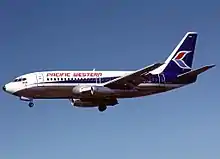Pacific Western Airlines Flight 314
On 11 February 1978, Pacific Western Airlines Flight 314, a Boeing 737-200, crashed at Cranbrook/Canadian Rockies International Airport, near Cranbrook, British Columbia, Canada, killing 42 of the 49 people on board.[1]
 A Pacific Western Boeing 737-200 similar to the one involved in the accident | |
| Accident | |
|---|---|
| Date | 11 February 1978 |
| Summary | Runway incursion caused by pilot error and ATC error, thrust reverser deployment during go-around |
| Site | Cranbrook/Canadian Rockies International Airport, Cranbrook, British Columbia, Canada 49.6114°N 115.78225°W |
| Aircraft | |
| Aircraft type | Boeing 737-200 |
| Operator | Pacific Western Airlines |
| Registration | C-FPWC |
| Flight origin | Fort McMurray International Airport |
| 1st stopover | Edmonton International Airport |
| 2nd stopover | Calgary International Airport |
| Last stopover | Cranbrook/Canadian Rockies International Airport |
| Destination | Castlegar Airport |
| Occupants | 49 |
| Passengers | 44 |
| Crew | 5 |
| Fatalities | 42 |
| Injuries | At Least 5 |
| Survivors | 7 |
The scheduled flight from Fort McMurray International Airport to Castlegar Airport via Edmonton, Alberta, Calgary, Alberta and Cranbrook, British Columbia crashed after its thrust reversers did not fully stow following an aborted landing to avoid a snowplow on the runway. Calgary air traffic control was in major error in its calculation of the flight's arrival time at Cranbrook, and the flight crew did not report while passing a beacon on final approach.[2][3]
Aircraft and crew
The aircraft involved was a Boeing 737-275 that was nearly eight years old at the time of the accident. It was powered by two Pratt & Whitney JT8D-9A turbofan engines.[4][5]
The captain was 30-year-old Chris Miles, who had been with Pacific Western Airlines since 1967 and became a Boeing 737 captain 10 years later in 1977. He had 5,173 flight hours, including 2,780 hours on the Boeing 737. The first officer was 25-year-old Peter Van Oort, who had been with the airline since 1971 and became a 737 first officer in 1977. He was less experienced than captain Miles, having logged 1,316 flight hours, but only 81 of them were on the Boeing 737.[6][7]
Accident
Flight 314 departed Calgary at 12:32 on an estimated 23-minute flight to Cranbrook. This estimate was passed to Cranbrook by Calgary Air Traffic Control.[6] Cranbrook was not a controlled airport, and while it had an "aeroradio" station to provide weather and advisory information to aircraft, it had no control tower or air traffic controllers.[6]
As Flight 314 neared the Cranbrook airport, it was snowing with a visibility of 3/4-mile, and a snow removal vehicle was clearing the runway. The Cranbrook aeroradio operator advised the snowplow of the estimated arrival of Flight 314 at 13:05. Flight 314 was expected to report on the approach when passing the "Skookum Beacon", which would give about seven minutes notice of arrival at Cranbrook.[6] At 12:45 Flight 314 contacted Cranbrook Aeroradio and was passed the latest weather and runway information.[6] At 12:47 Cranbrook Aeroradio advised Flight 314 that snow removal was in progress.[6]
After acknowledging the message about snow clearance in progress, Flight 314 made no further calls, and touched down on the runway at 12:55 about 800 feet from the threshold.[6] Flight 314 selected reverse thrust, but immediately cancelled it and started a go-around.[6] The aircraft flew down the runway at a height of 50 to 70 feet, flying over the top of the snow removal vehicle.[6]
The engine thrust reverser doors deployed, and the pilot decreased flaps from 40° to 15°. The landing gear remained locked in the down position.[6] Six seconds before impact, the aircraft was 4000 feet from the runway threshold when the left rudder was momentarily applied.[6] The aircraft climbed, then banked steeply to the left from a height of 300 to 400 feet, and crashed to the left of the runway.[6] The aircraft was destroyed by fire and the impact.[6]
Investigation
The crash investigation was conducted by the Aviation Safety Investigation Division of Transport Canada and audited by the Aircraft Accident Review Board.[6] Boeing simulations showed that the aircraft was controllable with one engine at idle reverse and the other at full forward thrust in a gear up, flaps 15° configuration. With flaps 25 and gear down, it was not possible to maintain level flight. The go-around would have been successful if the left engine thrust reverser doors had not been deployed.
In popular culture
The events of the crash featured in an episode of the History channel documentary Disasters of the Century, entitled "Collision Course".[8]
References
- Ranter, Harro. "Accident description". aviation-safety.net. Aviation Safety Network. Retrieved 11 January 2021.
- Ranter, Harro. "ATC transcript Pacific Western Flight 314 – 11 Feb 1978". aviation-safety.net. Aviation Safety Network. Retrieved 11 January 2021.
- "February 11, 1978 : Cranbrook, BC, Canada : Pacific Western Airlines, Flight 314 : Boeing B-737-275 (sic) : C-FPWC". www.planecrashinfo.com. Retrieved 11 January 2021.
- "Pacific Western C-FPWC (Boeing 737 - MSN 20142) (Ex CF-PWC)". www.airfleets.net. Airfleets aviation. Retrieved 11 January 2021.
- "C-FPWC Pacific Western Airlines Boeing 737-200". www.planespotters.net. Retrieved 11 January 2021.
- "Aircraft accident, Pacific Western Airlines Boeing 737, C-FPWC, Cranbrook, B.C., 11 February, 1978" (PDF). Aviation Safety Investigation Division, Aviation Safety Bureau, Transport Canada. H80001. Archived from the original (PDF) on 19 May 2014. Retrieved 19 May 2014 – via Federal Aviation Administration. (from Library and archives Canada cataloguing data)
- "Margin of Error: The crash of Pacific Western Airlines flight 314". Medium. 9 June 2020. Retrieved 11 January 2021.
- Collision Course (Documentary), Jason Malloy, 1 October 2005, retrieved 5 December 2020CS1 maint: others (link)